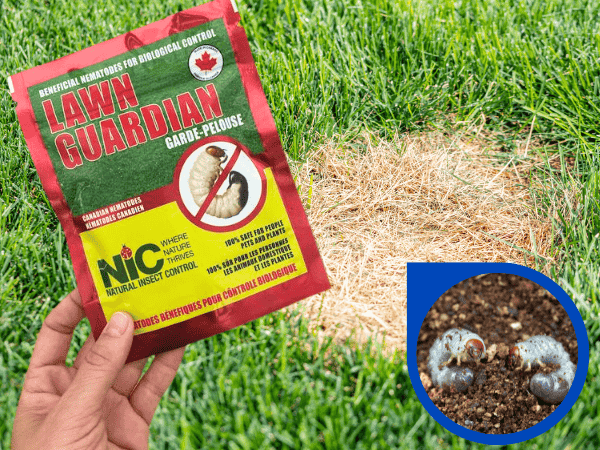
Applying Nematodes: Spring & Fall
A Natural Solution for a Healthy, Grub-Free Lawn
If you’ve battled brown patches, digging critters, or struggling turf, the culprit might just be grubs—the root-chomping larvae of various beetles. Thankfully, there’s a natural solution that’s safe for pets, people, and pollinators: beneficial nematodes.
Whether you’re tackling grubs in spring or fall, timing and soil temperature are key to success. Here’s everything you need to know to protect your lawn during both seasons.
What Nematodes Are Treating – The Grub Menace:
The Culprits
When we talk about nematode application, we’re primarily addressing a common lawn enemy: grubs. Grubs are the larval stage of various beetles, and they love to feast on the roots of your precious grass. Left unchecked, they can wreak havoc on your lawn, causing brown patches and weakening the overall health of your turf.

The Damage They Cause
Grubs are not your lawn’s friends. They voraciously devour the roots, leading to brown, wilted patches on your once-green carpet of grass. This damage can become particularly noticeable, especially during hot or dry weather. Worse yet, skunks and raccoons will dig up your lawn looking for these tasty snacks.

Why You Want to Get Rid of Grubs:
Lawn Health
A grub-damaged lawn becomes weak and vulnerable to disease, drought, and other stressors. Nematodes help stop the damage before it spreads.
Environmental Impact
Unlike chemical treatments, nematodes are microscopic, soil-dwelling worms that target only pest larvae. They’re 100% natural, safe (for humans & pets), and eco-friendly.
Prevent Digging Critters
By eliminating grubs, you also deter skunks, raccoons, and birds from tearing up your lawn in search of food.

When to Apply Nematodes for Grubs:
Spring Application
Spring is a great time to get ahead of grub damage—but only once the ground has warmed up.
- Wait until soil temperatures reach 10°C (50°F) or higher
- This typically happens in late April to early May in Ontario
- Treating in spring helps eliminate overwintered grubs before they mature
Note: Applying too early (when the soil is still cold) will make the nematodes ineffective.
Fall Application
Fall is the most popular time to apply nematodes, particularly in late August through September, when newly hatched grubs are near the surface and most vulnerable.
- Soil temperatures should again be above 10°C
- This application protects your lawn through winter and into the next season.

Optimal Soil Temperature
It’s essential to monitor soil temperatures to determine the right moment for nematode application. Aim for a soil temperature of around 10-20°C (50-68°F). This temperature range ensures that nematodes are most active and effective.
How to Apply Nematodes:
Prepare Your Lawn
Before applying nematodes, mow your lawn to a short height and remove any debris like leaves or thatch. This will help the nematodes penetrate the soil more effectively.
Hydrate Your Lawn
Nematodes need moisture to move through the soil. Water your lawn thoroughly before and after application. It’s crucial to maintain soil moisture throughout the process.

Mix and Apply
Follow the instructions on your nematode package for the correct mixing ratio. Typically, you’ll mix the nematodes with water and apply them evenly across your lawn using a sprayer or watering can. Apply in the early morning or late evening when temperatures are cooler to avoid sun exposure, which can harm nematodes.
Keep Moist
Continue watering lightly for the next few days to help them settle and spread.
Conclusion
Whether you’re prepping for a vibrant spring green-up or protecting your turf in the fall, nematodes are a natural and effective way to combat grubs. Just remember: soil temperature matters. Hold off until it’s 10°C or warmer for best results.
A simple application now means fewer pests, healthier roots, and a thicker, more resilient lawn through every season.


